Our Process for Hiring Software Engineers at Heyday

Hiring software engineers is one of the most pressing problems startup founders face.
But for most founders, recruiting is a skill that’s learned on the fly. When we started building our hiring process, Gitlab’s Hiring Handbook was hugely helpful to us. But, the constraints of a multi-billion dollar company and a 5-person startup are quite different.
Now that we’ve hired software engineers for our small team, we’ve decided to take a page out of Gitlab’s book to share our internal hiring process publicly — from sourcing to interviewing to hiring.
We hope it will be helpful to fellow early-stage founders and teams in the process of hiring software engineers for the first time.
Quick Navigation
Sourcing Software Engineers
At Heyday, we refer to finding and messaging candidates that have the experience we’re looking for in our open roles as “sourcing.”
We rely on an applicant tracking system, job boards, and job search marketplaces to power our sourcing efforts.
Applicant Tracking System
Lever
We use Lever to operate and track all parts of our recruiting process from reviewing applications to extending offers. We used Greenhouse in the past but switched to Lever for ease of use.
Job Boards
Product Hunt’s job board connects people with early-stage companies. We post our frontend engineer position here.
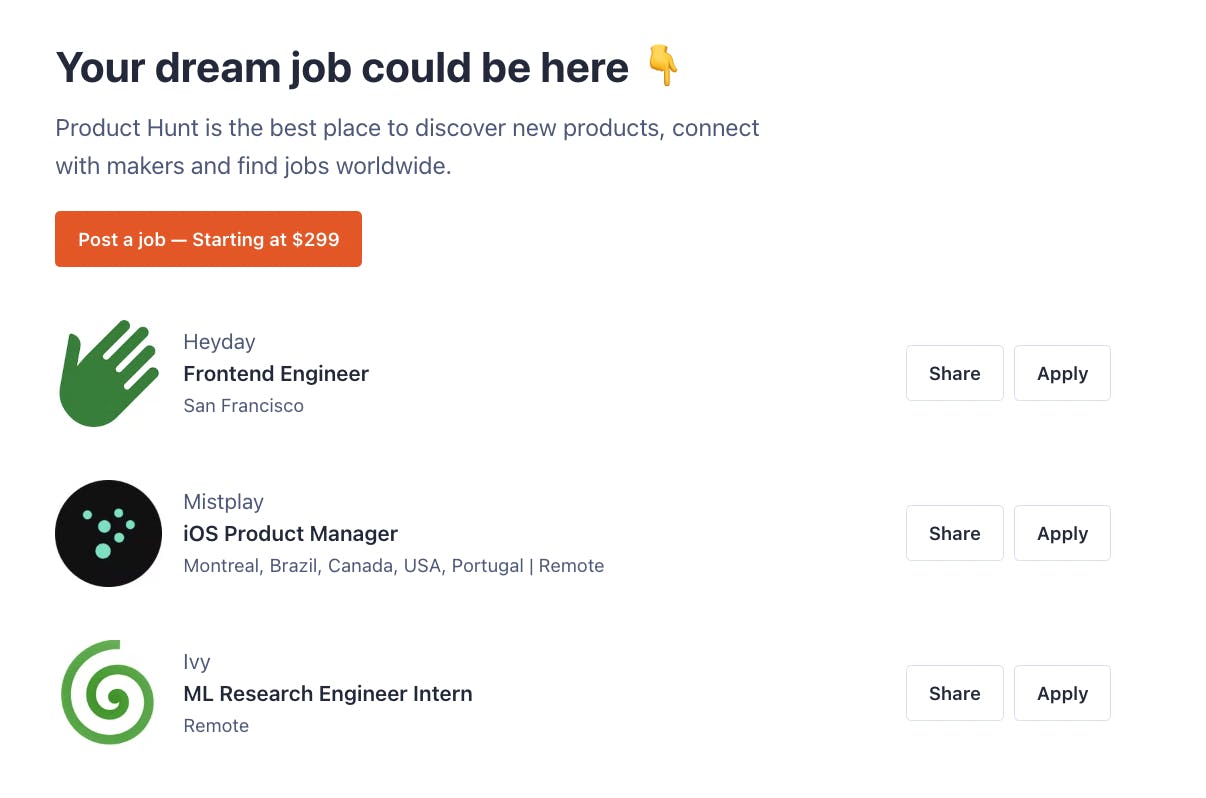
Authentic Jobs is a job board for designers, developers, and creators. We post our backend engineer position here.
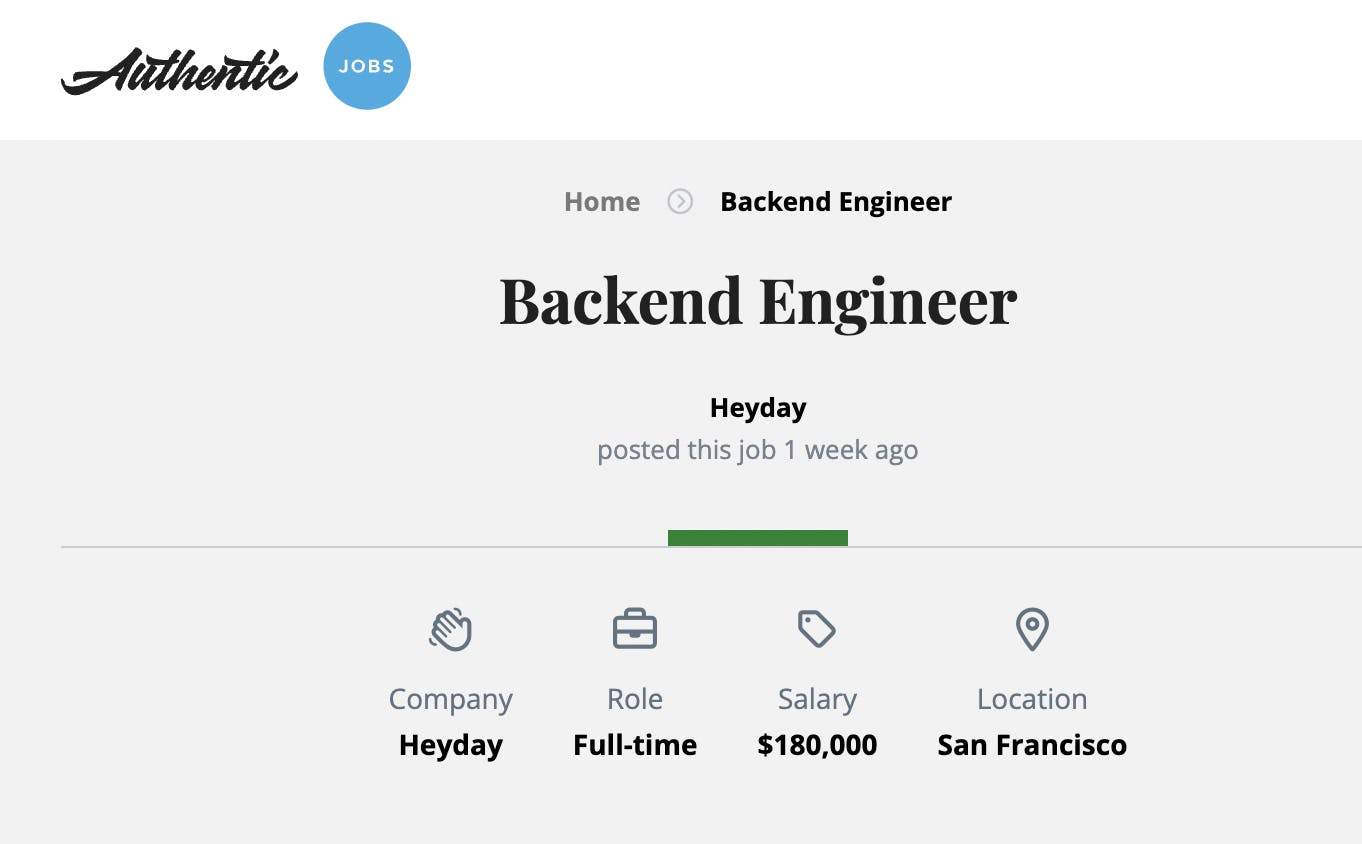
Job Search Marketplaces
Pallet helps community leaders curate candidates that companies want to hire. We’ve had success sourcing candidates from Gergely Orosz’s Pragmatic Engineer Talent Collective.
Process
- Login with Samiur’s account (ask Sam for credentials)
- View Pallet's “talent collectives” in Pragmatic Engineer community
- Apply search filters (below)
- Save qualified candidates
- Mark unqualified candidates as “not interested”
- View “Saved”
- “Request to chat” with qualified candidates
- Copy and paste the appropriate message
- If a candidate accepts, manually add them to Lever before the interview
Search Filters
- Primary skillset: Software Engineering
- Experience: Junior, Mid-level, Senior, Expert
- Work preference: Full-time
- Location: San Francisco
Hired is a marketplace for engineers seeking jobs and employers looking to hire them. We run searches for frontend and backend engineers here.
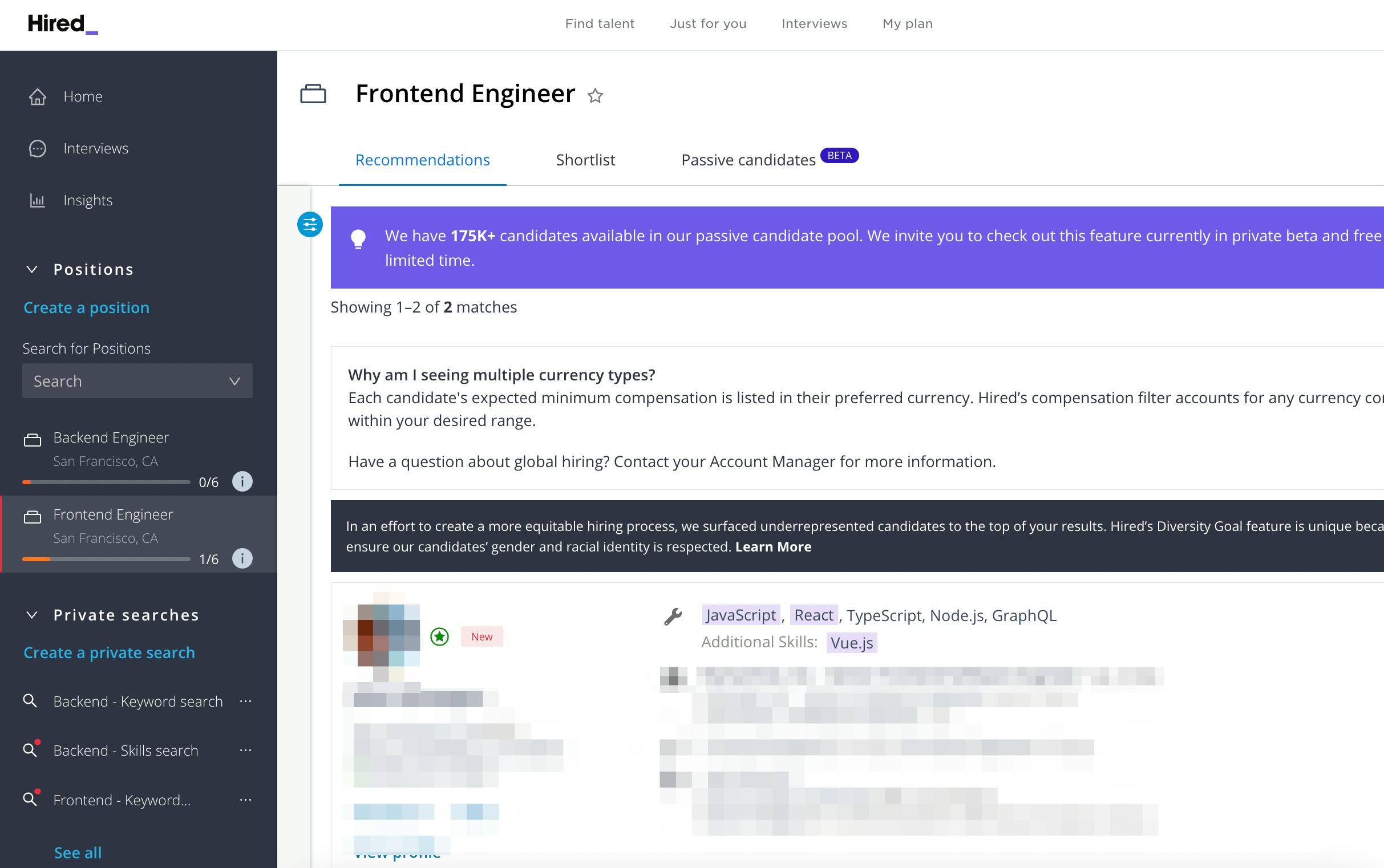
We run searches to find candidates and message qualified ones.
- Frontend Engineer - Keyword search: React
- Backend Engineer - Skills search: Distributed systems, databases, Erlang, Elixir, Cassandra, Kubernetes, Clojure, Haskell, Kafka, SQLAlchemy, AWS, Docker, elasticsearch, kibana, data infrastructure
Underdog connects job seekers with startups that are hiring. We run searches for frontend and backend engineers here.
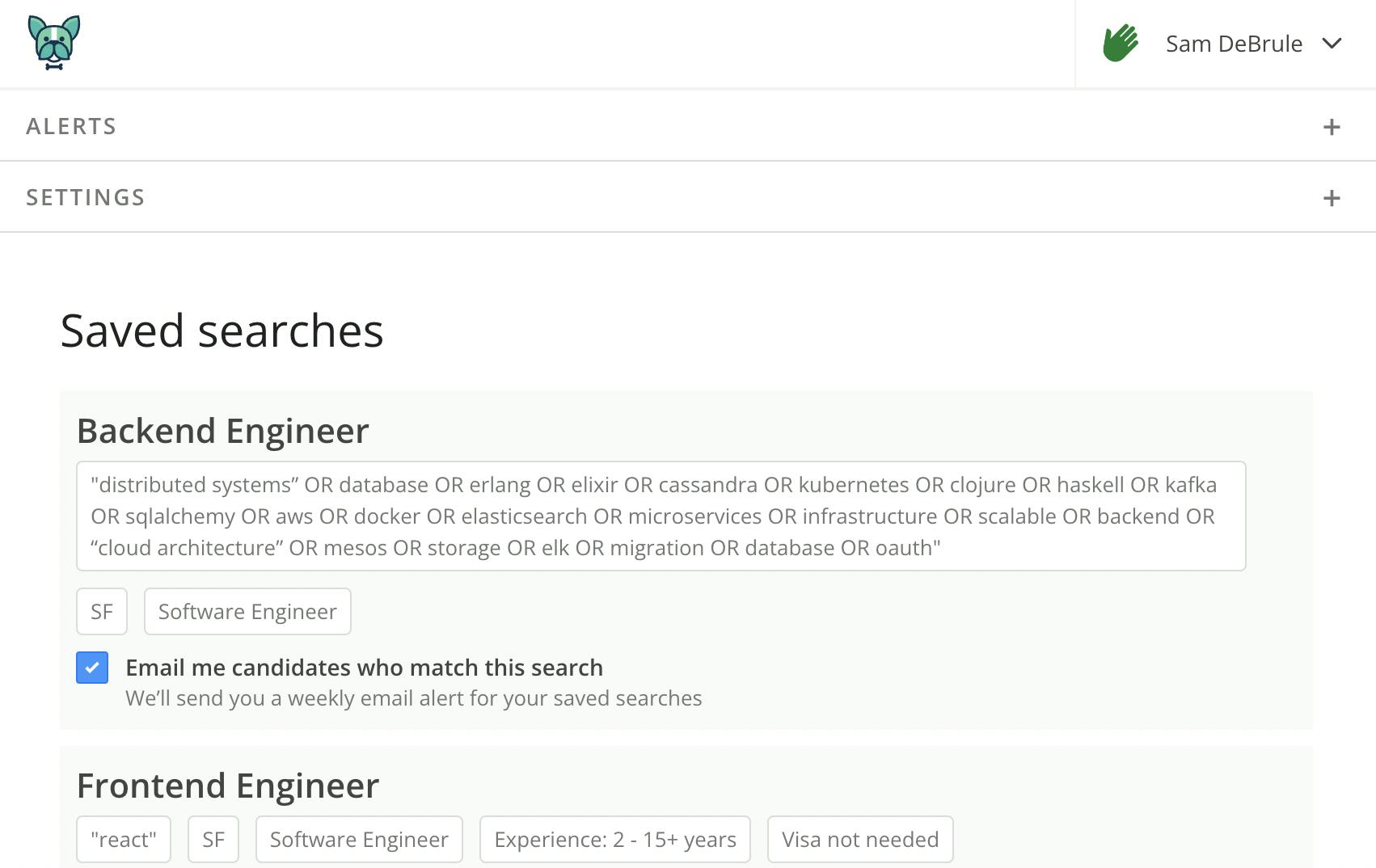
Underdog does “talent drops” at 6am PT every Monday. To increase candidate response rates, they encourage you to message candidates as close to that time as possible. I have a reminder set to do so
Our Process
- View saved searches
- Hide unqualified candidates
- Star qualified candidates
- Export starred candidates to lever
- [In Lever] Send “Underdog Sourced - Outreach for PS1 - BE” or “Underdog Sourced - Outreach for PS1 - FE” email
Our searches
- Frontend Engineer saved search: "react", SF, Software Engineer, Experience: 2 - 15+ years,
- Backend engineer saved search: "distributed systems” OR database OR erlang OR elixir OR cassandra OR kubernetes OR clojure OR haskell OR kafka OR sqlalchemy OR aws OR docker OR elasticsearch OR microservices OR infrastructure OR scalable OR backend OR “cloud architecture” OR mesos OR storage OR elk OR migration OR database OR oauth, Experience: 2 - 15+ years
Entelo creates aggregate profiles of candidates and scores their willingness to leave their current employer. We use Entelo to find candidates and message qualified ones.
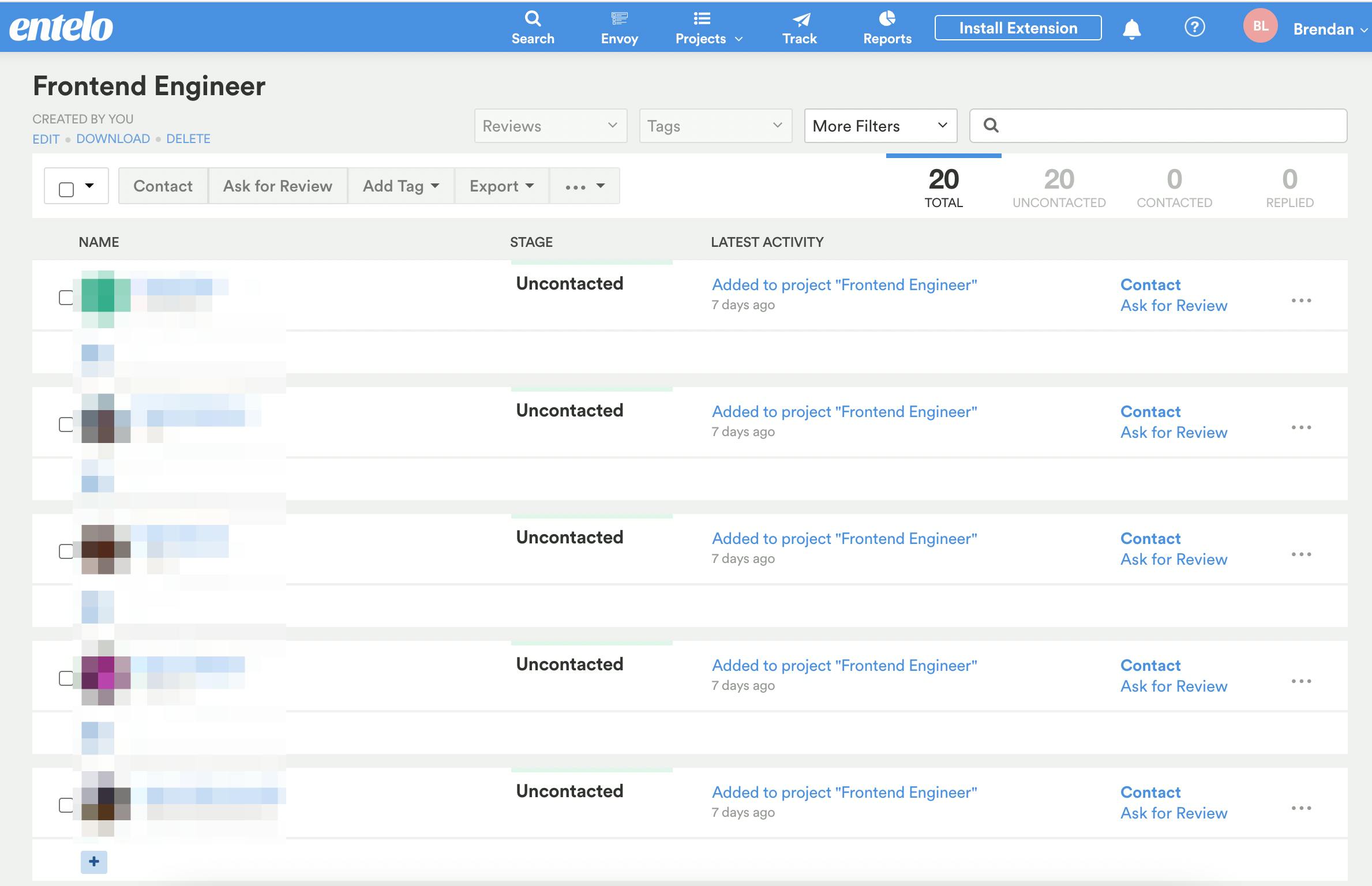
Saved searches for Frontend candidates
Saved searches for Backend candidates
Meetings
We use Calendly to streamline the interview scheduling process with candidates.
In the details of the invite, we include Zoom call-in details, example questions, the relevant job description, and a blurb about Heyday.
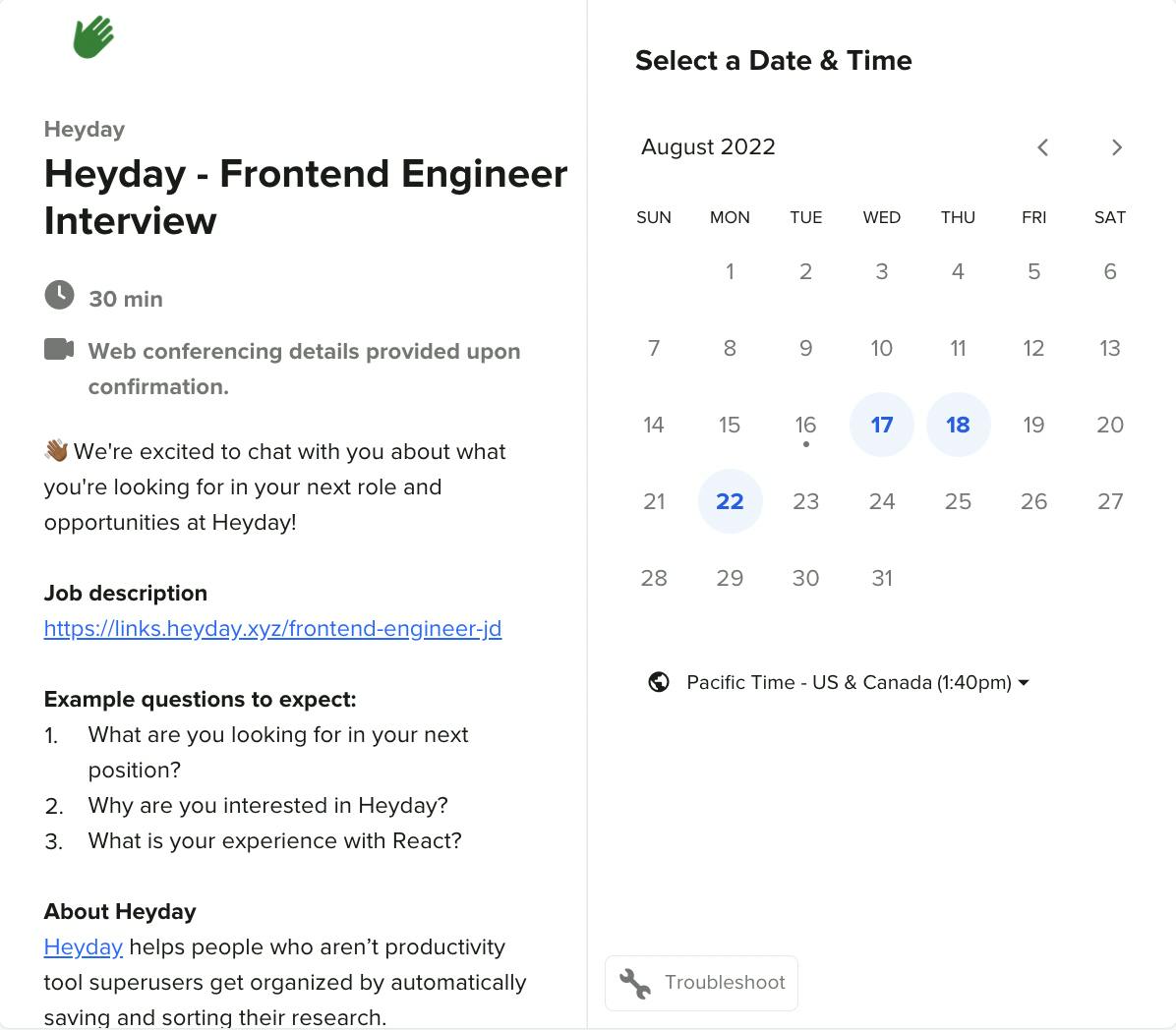
We use Zoom to have interviews with candidates. Candidates determine whether they want to use video or just audio.
Sourcing Benchmarks
We actively run experiments to identify new sourcing channels to add to our mix. When we evaluate a channel, we talked into account the cost of the platform, effort for our team, and intent level of candidates on the platform.
Here are benchmarks we’ve established from our past sourcing experiments:
Hired.com sourcing experiment results
- 387 messages sent
- 155 requests accepted (47%)
- 2 offers made
- 2 offers accepted
- $36,000/year
- $18,000 cost/hire
- 13 days from outreach to hire
Entelo sourcing experiment results
- 750 messages sent
- 5 requests accepted (0.7%)
- 1 offer made
- 1 offer accepted
- $10,000/year
- $10,000 cost/hire
- 17 days from outreach to hire
Future sourcing experiment backlog
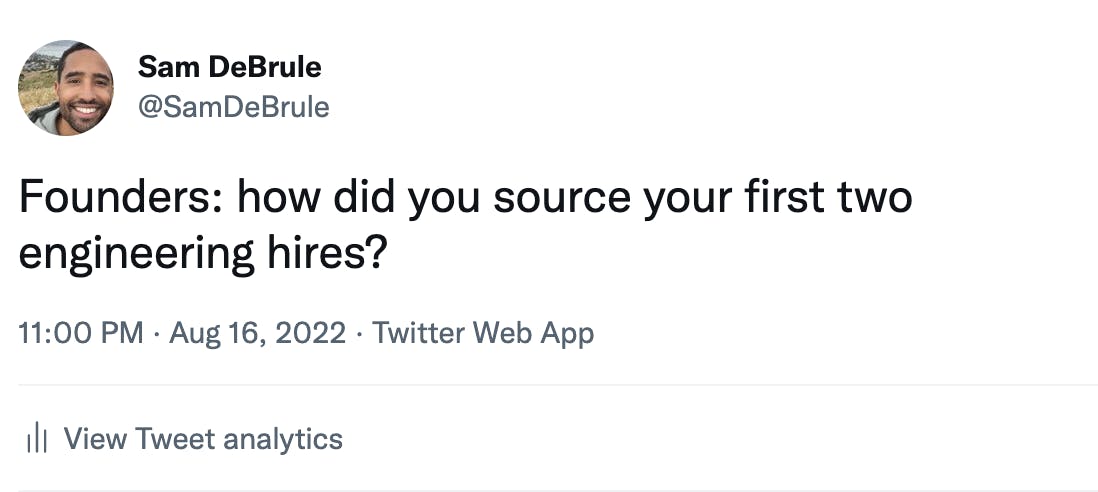
We polled founders on Twitter to learn how they went about hiring software engineers for their teams. Here are the results:
- Daniel Baum, co-founder of Sleek - "1st: networking and willingness to speak with anyone, anywhere (Eng. 1 was in Kosovo, we brought him to Canada). 2nd: inbound interest, heard about us from a TC article."
- Veeraj Mehta, founder of Puzzl - "asked everyone for referrals lol"
- Josh Ho, founder of ReferralRock - "Angellist."
- Drew Volpe, investor at First Star Ventures - "1st startup: Craigslist. 2nd startup: iOS meetup and LinkedIn DMs"
- Andres Gonzalez, co-founder of Cadenzo - "#1 was a cold message to a college student on LinkedIn, #2 was a referral from a founder friend."
- David Nohe, CEO at FinGoal - "Going to dev meetups and meeting lots of people."
And here are the additional sources we plan to experiment with as well:
- AngelList - Low-Medium intent. Mostly junior candidates.
- gun.io - Specific for engineers. 13 days average time to hire. Faster than any others recorded.
- otta - High intent candidates
- HackerRank Jobs - Assessment platform with focus on the end-to-end experience, includes live interviewing.
- HireEZ - Sources candidate profiles from 45 open web platforms.
- Human Predictions - Predicts who is looking for a job right now.
- Interviewing.io - Technical screenings
- Dover - Fully managed recruiting process
- Gem - Talent CRM with sourcing product
- Tech Ladies - Job board
- Women Who Code - Job board
- Twitter DMs - Time intensive, low intent
- LinkedIn Recruiter - Time intensive, low intent
Interviewing Software Engineers
Job Descriptions
We share our Frontend Engineer and Backend Engineer job description with candidates to excite them about our company and vision, explain the responsibilities of the role, and give them a sense of the people they will be working alongside.
Hiring Stages
- Application Review - This stage typically consists of one event, which is the application review. Sam (co-founder) reviews the applications and decides if he wants to advance or reject a candidate.
- Phone screen 1 - This stage has only the screening call, where Sam (co-founder) or Brendan (chief of staff) does an initial call with the candidate to review their experience, communication skills, and values alignment. We use the STAR Method to understand candidates’ previous experience
- Phone Screen 2 - The "Technical Interview" is typically done with Mark (head of engineering/hiring manager). In this interview, the candidate will be evaluated on technical ability and communication. Frontend candidates are tasked with extending a react component. Backend candidates develop a new API and associated data structures
- Onsite Interview - This stage consists of two interviews - one programming interview with other members of the engineering team and one behavioral interview.
- Offer - This is where Sam (co-founder) and Mark (head of engineering/hiring manager) prepare the offer and the offer is approved or rejected by the candidate.
Interview Scoring
- Strong Hire - Very likely to hire (meets most requirements, aligns with values)
- Hire - Semi-inclined to Hire (meets some requirements, some areas for further exploration)
- No Hire - Not likely to hire (meets few requirements, has many yellow flags, may not align with values well)
- Strong No Hire - Would not hire (does not meet requirements, red flags, not aligned with values)
Salary bands
We give candidates the option to choose salary/equity packages within their level to maintain pay equity.
Engineer Levels
Level 3
- Contribute to discussions on higher-level architectural direction
- Writes engineering specs within existing infrastructure/footprint
Level 4
- Mentors other engineers
- Writes engineering specs in greenfield areas
Level 5
- Leads a cross-discipline engineering meeting
- Leads a "Feature Pod" of other engineers/designers
Level 6
- Contributes to setting company-level objectives as it relates to engineering
Level 7
- Direct reports
Relocation Bonus
We offer candidates a relocation bonus that is equal to 10% of their annual salary.
Hiring Software Engineers
Interview Schedule
First Phone Interview
- Interviewers: Sam
- Length: <30 minutes
- Evaluating: Experience, Communication, Values Alignment
Second Phone Interview
- Interviewers: Mark
- Length: 60 minutes
- Evaluating: Technical Skills, Communication, Values Alignment
Onsite Interview
- Interviewers: Sam, Samiur, Team, Mark
- Length: 3 hours
- Evaluating: Technical Skills, Communication, Values Alignment
Hiring Timeline
- Sourcing - We use our sourcing channels to find candidates for the vacancy.
- Phone screen 1 - If the candidate qualifies for consideration, Sam (co-founder) or Brendan (chief of staff) schedule a screening call. Sam/Brendan moves the candidate to the "Phone Screen 1" stage in Lever. They send the candidate the appropriate calendly link to collect their availability and send out calendar invitations to both the interviewer and candidate. Sam/Brendan conduct a screening call. They will either reject a candidate or move the candidate to the Phone Screen 2 (technical interview) stage in Lever.
- Phone Screen 2 (technical interview) - Mark (head of engineering does) a collaborative programming exercise with the candidate using codesandbox or repl.it to assess candidates’ coding and communication skills.
- Onsite interviews - All interviewers assess the candidate's values alignment by asking behavioral questions and scoring the values alignment as part of their feedback form in Lever. A longer programming exercise takes place and a dedicated behavioral interview as well.
- Offer - After a successful onsite interview, we make an offer to the candidate. Samiur (CEO) and Mark (hiring manager) call candidate and make verbal offer. Sam moves the candidate to the "Offer" stage in Lever. Samiur sends email to candidate with informal offer. Sam sends official offer letter from Rippling. Samiur meets with candidate for coffee to answer questions. Samiur follows up to ensure that the offer is accepted and that the contract is signed.
- Offer accepted - Team sends individual congratulations emails to new teammate.
Building Heyday in Public
This post is the latest entry in our series of building Heyday in public. Check out the other learnings we’ve shared publicly:
- Heyday’s $6.5M Seed Pitch Deck
- How Heyday Won #1 Product of the Month on Product Hunt
- How we lowered our churn by 3x
- Build in Public Inspiration for founders
Doing research as you build your own hiring process?
Heyday will save you time and help you retain more of what you learn.